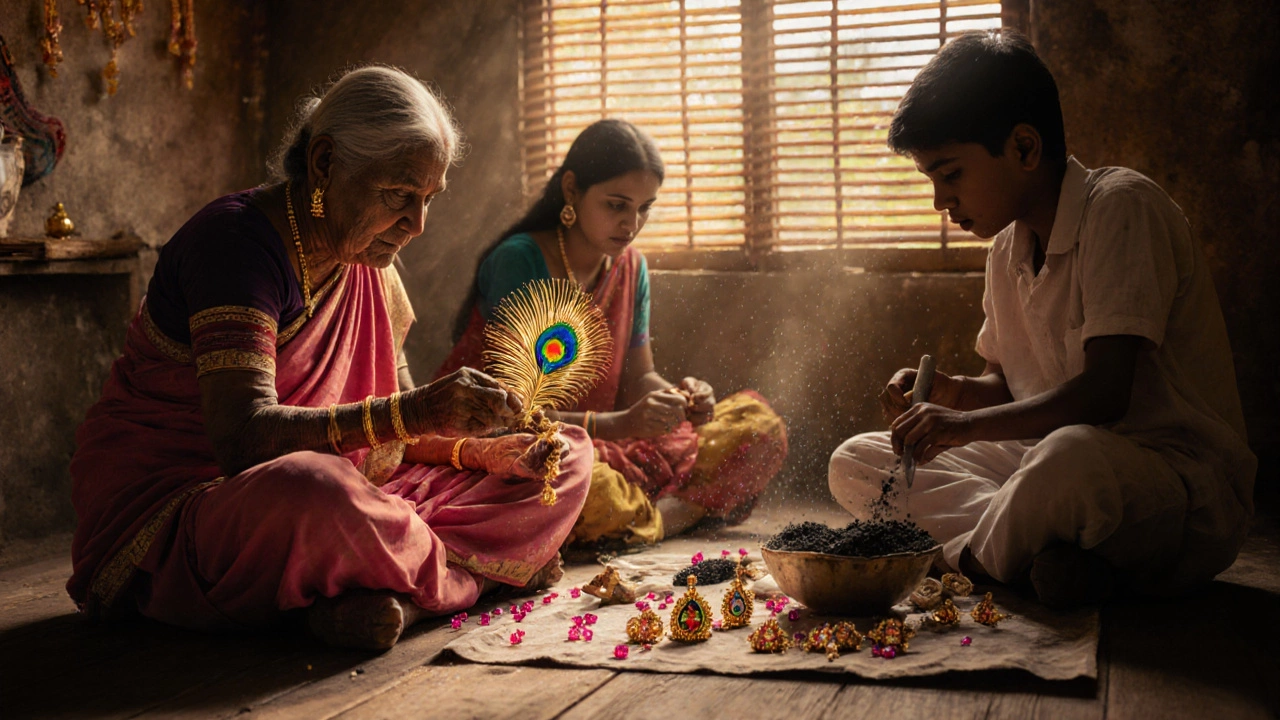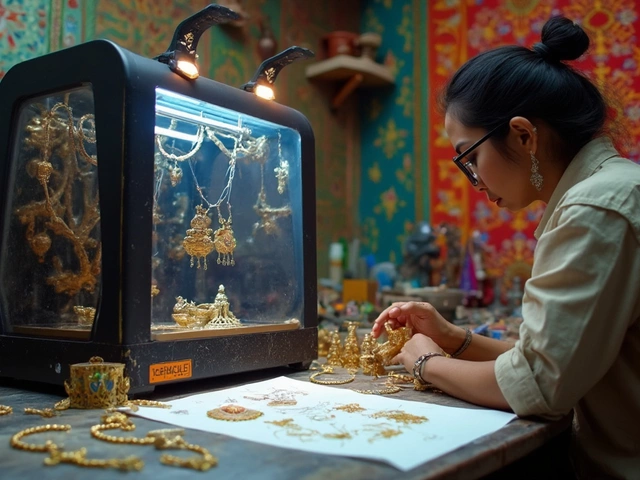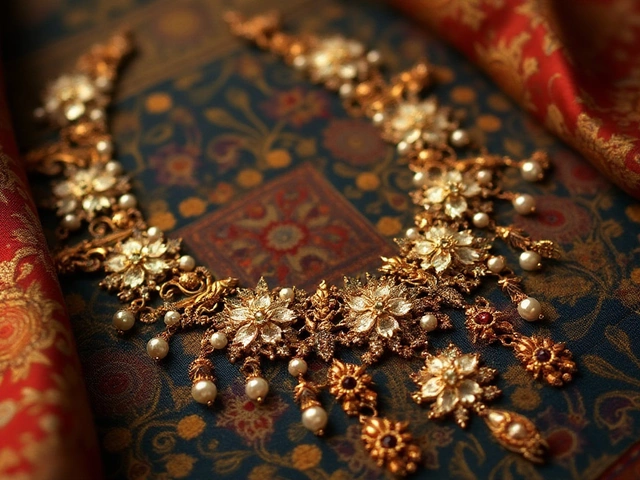Temple Jewelry Authenticity Checker
Check if your jewelry matches authentic temple jewelry characteristics based on the article's verification criteria.
Verify Your Temple Jewelry
Verification Results
Verification items:
Enter your jewelry details to check authenticity.
When you see a woman in a silk saree with heavy gold earrings shaped like gods and goddesses, or a bride wearing a necklace with tiny bells that chime as she walks, you’re looking at temple jewelry. This isn’t just decoration-it’s worn history. But where does all of it come from? Not from big jewelry chains. Not from online marketplaces. Most temple jewelry in India is made in small workshops, passed down through generations, and shaped by centuries of ritual, skill, and devotion.
Temple Jewelry Starts in Tamil Nadu and Andhra Pradesh
Over 80% of India’s authentic temple jewelry is made in just two states: Tamil Nadu and Andhra Pradesh. Within these, the towns of Kanchipuram, Chidambaram, and Sivakasi are the beating heart of this craft. In Kanchipuram, for example, families have been making temple jewelry for over 300 years. Their workshops aren’t factories-they’re homes. A grandmother sits at a low table, hammering gold into the shape of a peacock’s feather. Her daughter files the edges smooth. The grandson, just learning, mixes natural resin with powdered minerals to create the black enamel that outlines the designs.
This isn’t mass production. Each piece takes 3 to 15 days to finish. A single jhumka (earring) might have 12 tiny figures of Lord Shiva or Goddess Lakshmi, each carved by hand. The gold used is usually 22-karat, not 24, because it’s strong enough to hold the intricate shapes without bending. The stones? Not diamonds. They’re uncut rubies, emeralds, and pearls-selected for their natural color and texture, not for sparkle.
Temple Jewelry Was Made for Gods First
Before it ever touched a human ear or neck, temple jewelry was made for deities. In Tamil Nadu’s biggest temples-like Meenakshi Amman in Madurai or Sri Ranganathaswamy in Srirangam-idols are dressed daily. Their crowns, necklaces, and armlets are changed based on the season, festival, or time of day. These ornaments are called alankaram. They’re not just beautiful-they’re sacred.
Artisans who make these pieces are often from communities like the Sthapathis or Karigars, who’ve worked for temples for generations. Their skills are taught orally, not in schools. A boy learns by watching his father, then his grandfather. He doesn’t learn to make a necklace-he learns to make the face of a goddess exactly as it was carved 200 years ago. Accuracy matters more than speed.
Today, many of these same artisans make jewelry for brides and women attending weddings. But the designs haven’t changed. A maang tikka with a central pendant shaped like a lotus? That’s the same as the one placed on the forehead of the goddess during the Aradhana ceremony.
How Temple Jewelry Moves From Workshop to Wedding
Temple jewelry doesn’t show up on Amazon or Flipkart. It travels through a quiet, trusted network. Local jewelers in temple towns buy directly from the artisans. Then, they sell to wholesalers in cities like Chennai, Hyderabad, and Bangalore. These wholesalers, in turn, supply smaller shops across India. A bride in Kerala might buy her temple jewelry from a shop in Thrissur that gets its stock from a wholesaler in Kanchipuram.
Some families keep their jewelry for decades. A mother might pass down her wedding set to her daughter. That’s why you’ll see the same design in a 70-year-old woman’s collection and a 22-year-old bride’s trousseau. It’s not about trends-it’s about continuity.
There’s also a growing market among the Indian diaspora. Women in the U.S., U.K., and Australia now order temple jewelry directly from artisans in Tamil Nadu through WhatsApp or Instagram. But even then, the pieces are still made the same way: hand-carved, hand-set, hand-polished. No machines. No molds. No shortcuts.
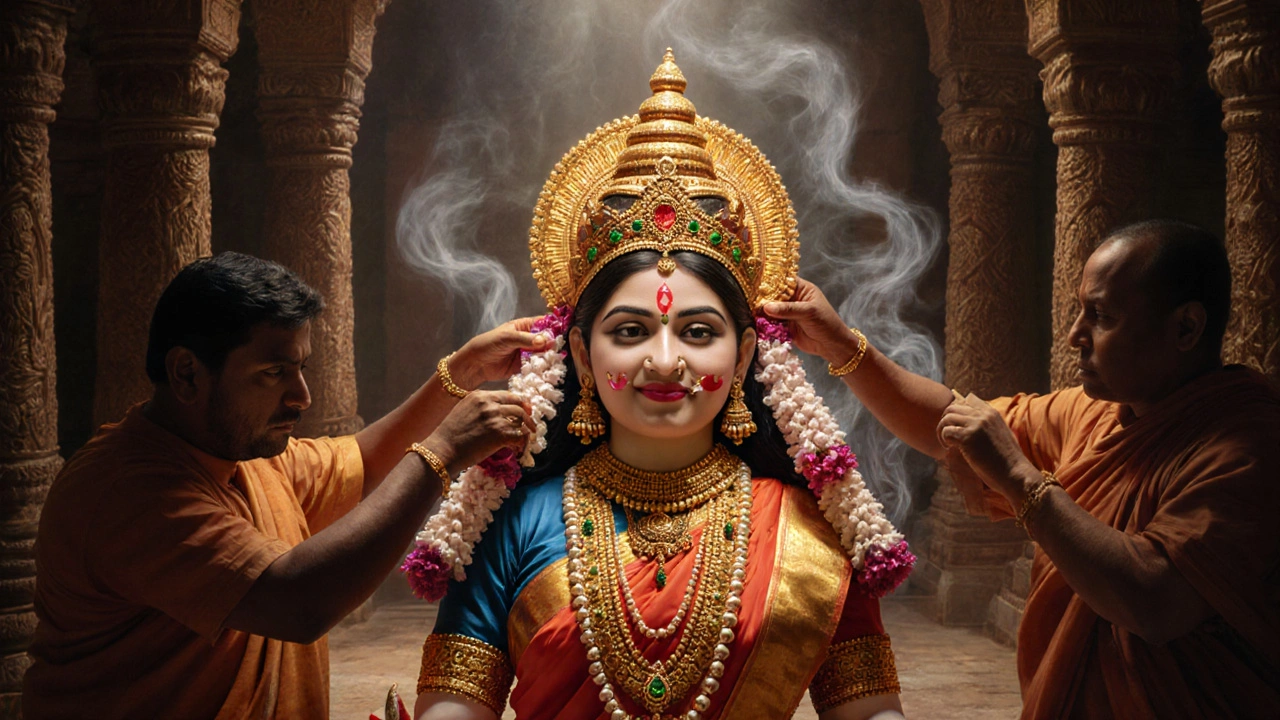
What Makes Temple Jewelry Different From Regular Gold Jewelry
Not all Indian gold jewelry is temple jewelry. Here’s how to tell the difference:
- Designs: Temple jewelry features deities, peacocks, lotus flowers, and mythological symbols. Regular gold jewelry uses floral patterns, geometric shapes, or abstract swirls.
- Weight: Temple pieces are heavier. A single necklace can weigh 150-250 grams. Regular bridal sets are often lighter, under 100 grams.
- Enamel work: Black enamel (called kundan or meenakari) outlines figures. This is rare in regular jewelry.
- Stones: Temple jewelry uses uncut natural stones. Regular jewelry often uses cut diamonds or synthetic stones.
- Purpose: Temple jewelry is worn during religious events, weddings, and festivals. Regular gold is worn daily or for parties.
That’s why temple jewelry costs more. A 200-gram necklace made by a master artisan can cost between ₹80,000 and ₹2,50,000. A similar-weight regular gold necklace made in a factory might cost ₹50,000. The difference? The time, the skill, the story.
Why It’s Hard to Find Authentic Temple Jewelry Today
There’s a big problem: fake temple jewelry is everywhere. Online sellers use the term loosely. You’ll find “temple jewelry” on Etsy or Alibaba made from brass with glass stones. They’re cheap, shiny, and completely disconnected from the tradition.
How do you know it’s real? Look for these signs:
- Handmade imperfections-tiny scratches, uneven edges, slight variations in design. Machine-made pieces look too perfect.
- Black enamel that’s slightly raised, not flat. Real enamel is applied by hand and cured slowly.
- Gold that’s 22-karat, not 18-karat or lower. Check for the BIS hallmark.
- Ask where it was made. If the seller says “Made in India” without naming a town like Kanchipuram or Sivakasi, be skeptical.
Many buyers don’t realize they’re paying for a factory-made imitation. Real temple jewelry isn’t sold in malls. It’s bought from trusted jewelers who’ve been in business for 30+ years-or directly from artisans at local fairs in Tamil Nadu.
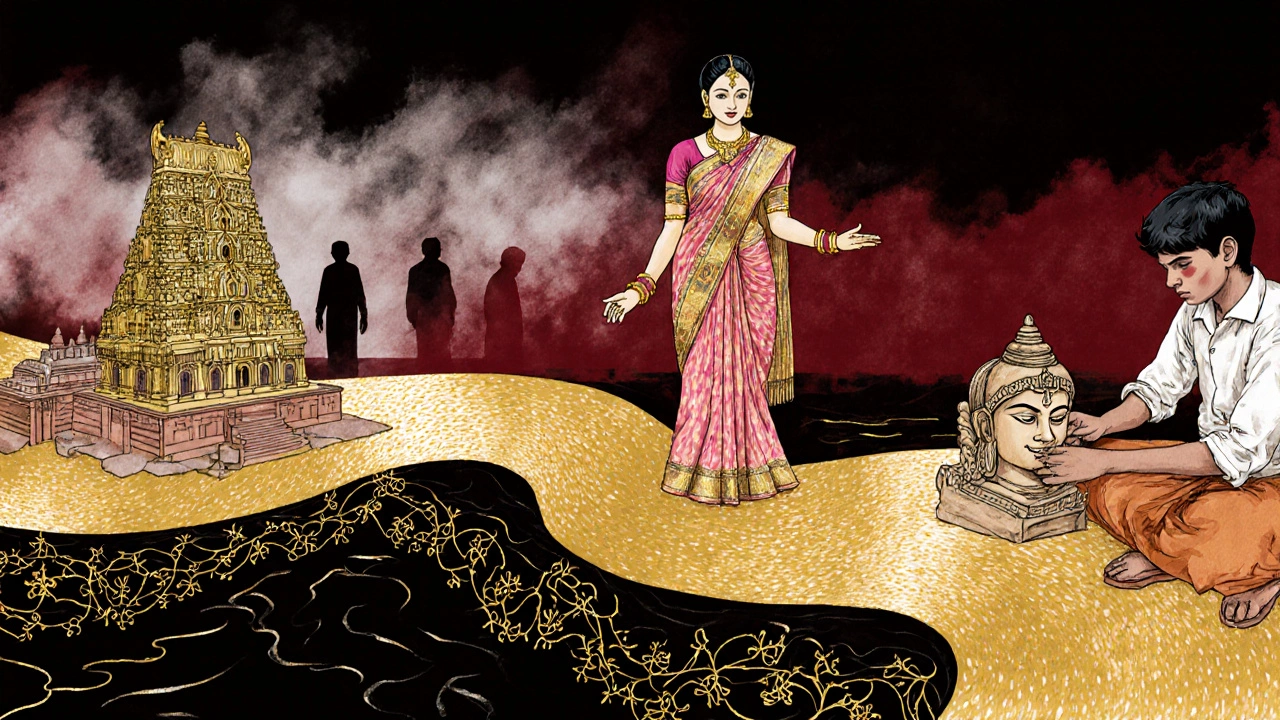
Who Keeps This Tradition Alive?
There are fewer than 2,000 master artisans left in Tamil Nadu who still make temple jewelry the old way. Most are over 50. Their children are moving to cities for software jobs. The craft is fading.
But there’s hope. NGOs like the Handloom and Handicrafts Development Corporation and the Central Silk Board are training young people. Some designers in Delhi and Mumbai are collaborating with temple artisans to create modern versions-lighter, smaller, but still handcrafted. These pieces are worn with jeans and kurtas, not just sarees.
Even Instagram influencers are helping. A post showing a 10-minute video of an artisan carving a tiny Shiva face can reach 500,000 people. Suddenly, young Indians are asking: “Can I buy this?” And yes-they can. But only if they know where to look.
Where to Buy Real Temple Jewelry Today
If you want real temple jewelry, here’s where to go:
- Kanchipuram, Tamil Nadu: Visit the jewelry lanes near the Kanthaswamy Temple. Ask for shops run by families with over 4 generations in the trade.
- Sivakasi, Tamil Nadu: Known for fireworks, but also home to dozens of small workshops making temple jewelry for South Indian weddings.
- Chennai’s Ranganathan Street: A maze of gold shops. Look for signs that say “Temple Jewelry” and ask to see the artisan’s signature on the back of the piece.
- Online (trusted only): Websites like Handloom India or CraftsVilla work directly with artisans. Check their “About Us” page-do they name the maker? Do they show photos of the workshop?
Avoid Amazon, Flipkart, or eBay for temple jewelry. The chances of getting a fake are over 90%.
It’s Not Just Jewelry-It’s a Legacy
When an Indian woman wears temple jewelry, she’s not just accessorizing. She’s carrying a piece of a thousand-year-old story. The same hands that once adorned a temple idol now adorn her on her wedding day. The same symbols that once whispered prayers in stone now hang from her ears.
This jewelry doesn’t come from a supply chain. It comes from a lineage. From fathers to daughters. From temples to homes. From silence to song.
So if you ever wonder where Indians get their temple jewelry-remember: it’s not bought. It’s inherited. Made. Remembered.
Is temple jewelry only worn by women in India?
No. While most commonly worn by women, men in South India also wear temple-style jewelry during religious ceremonies. Men’s pieces include gold armlets, chest ornaments called kanthi mala, and headbands with divine symbols. These are typically worn by priests, temple dancers, or during festivals like Pongal or Navaratri.
Can temple jewelry be worn daily?
Traditionally, no. Temple jewelry is heavy and meant for special occasions. But modern versions, made lighter with thinner gold and fewer stones, are now designed for daily wear. These are called “fusion temple jewelry” and are popular among urban women who want cultural style without the weight.
Why is temple jewelry so expensive?
It’s expensive because it’s handmade by master artisans using 22-karat gold and natural stones. Each piece takes days to complete, with no machines involved. The labor cost alone can be higher than the value of the gold. You’re paying for centuries of skill, not just metal and stones.
Do all Indian states make temple jewelry?
No. Only Tamil Nadu, Andhra Pradesh, and parts of Karnataka have the deep-rooted tradition. Other regions like Punjab or Maharashtra have their own styles-like Kundan or Polki-but they’re not temple jewelry. Temple jewelry is defined by its religious iconography and origin in South Indian temple traditions.
How can I verify if temple jewelry is authentic?
Look for the BIS hallmark on the gold, check for handcrafted imperfections, and ask where it was made. Authentic pieces will have black enamel that’s slightly raised and uneven. If the seller can’t name a town like Kanchipuram or Sivakasi, it’s likely mass-produced. Trust sellers who show photos of the artisan at work.
